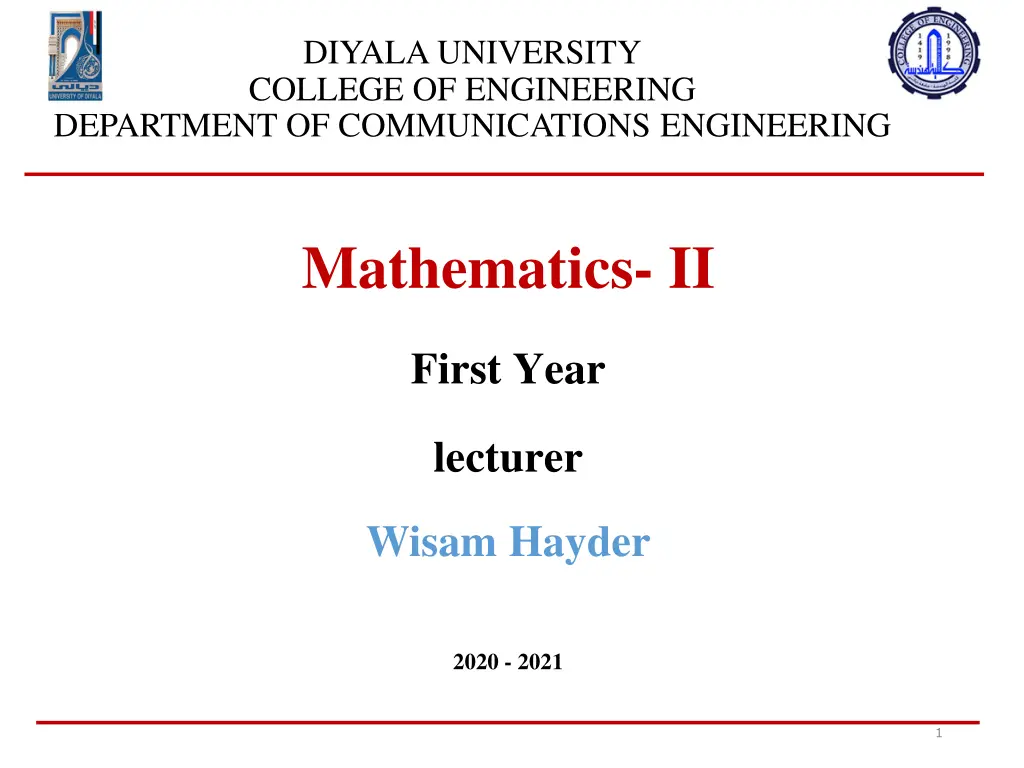
Understanding First-Order Differential Equations in Mathematics
Dive into the world of first-order differential equations in mathematics. Learn about solutions, slope fields, Euler's method, and classification based on type, order, and degree. Explore ordinary and partial differential equations, general solutions, and more.
Download Presentation

Please find below an Image/Link to download the presentation.
The content on the website is provided AS IS for your information and personal use only. It may not be sold, licensed, or shared on other websites without obtaining consent from the author. If you encounter any issues during the download, it is possible that the publisher has removed the file from their server.
You are allowed to download the files provided on this website for personal or commercial use, subject to the condition that they are used lawfully. All files are the property of their respective owners.
The content on the website is provided AS IS for your information and personal use only. It may not be sold, licensed, or shared on other websites without obtaining consent from the author.
E N D
Presentation Transcript
DIYALA UNIVERSITY COLLEGE OF ENGINEERING DEPARTMENT OF COMMUNICATIONS ENGINEERING Mathematics- II First Year lecturer Wisam Hayder 2020 - 2021 1
First-Order Differential Equations Solutions, Slope Fields, and Euler s Method Differential Equations A differential equation is an equation that involves one or more derivatives, or differentials. 2
Differential equations are classified by: 1. Type: Ordinary or partial. 2. Order: The order of differential equation is the highest order derivative that occurs in the equation. 3. Degree: The exponent of the highest power of the highest order derivative. 3
First-Order Differential Equations A differential equation is an ordinary D. Eqs. if the unknown function depends on only one independent variable. If the unknown function depends on two or more independent variable, the D.Eqs. is a partial D.Eqs.. 4
First-Order Differential Equations Solution The solution of the differential equation in the unknown function y and the independent variable x is a function y(x) that satisfies the differential equation. 7
First-Order Differential Equations Note: The solution in example above is called general solution since it's contain an arbitrary constant c1 and c2, i.e. the general solution of differential equation is the set of all solutions, and the particular solution is any one of these solutions. 8
First-Order Differential Equations Example: Solve the IVP: ? = ?? ??,? ? = ?,? ? = ?. Sol. We need to double integration. 9 ? = 3? 3?+ ?1= 3? 3?+ ?1 ? 0 = 2= 3?0+ ?1,?1= 5 = 3? 3?+ 5 ? = ? 3?+ 5? + ?2, ??????? ????????? ? 0 = 1 ? 0 = 1, 1 = 1+ 5 0 + ?2, ?2= 0 The solution is the given initial VPI is ? = ? 3?+ 5? 12
Slope Fields: Viewing Solution Curves Each time we specify an initial condition ?(??) = ??for the solution of a differential equation ? = ?(?,?) the solution curve (graph of the solution) is required to pass through the point (??,??) and to have slope f(??,??) there. We can picture these slopes graphically by drawing short line segments of slope (x, y) at selected points (x, y) in the region of the xy-plane that constitutes the domain of . 13
Each segment has the same slope as the solution curve through (x, y) and so is tangent to the curve there. The resulting picture is called a slope field (or direction field) and gives a visualization of the general shape of the solution curves. Figure 9.2a shows a slope field, with a particular solution sketched into it in Figure 9.2b. We see how these line segments indicate the direction the solution curve takes at each point it passes through. 14
Eulers Method If we do not require or cannot immediately find an exact solution giving an explicit formula for an initial value problem ? = ? ?,? ,? ?? = ?? Given a differential equation ?? ?? = ? ?,? and an initial condition ? ?? = ?? we can approximate the solution y= y(x) by its linearization 16
The function L(x) gives a good approximation to the solution y(x) in a short interval about ??(Figure 9.4). We know the point (??,??) lies on the solution curve. Suppose that we specify a new value for the independent variable to be ?1= ??+ dx. Recall that dx = x in the definition of differentials. If the increment dx is small, then 17
